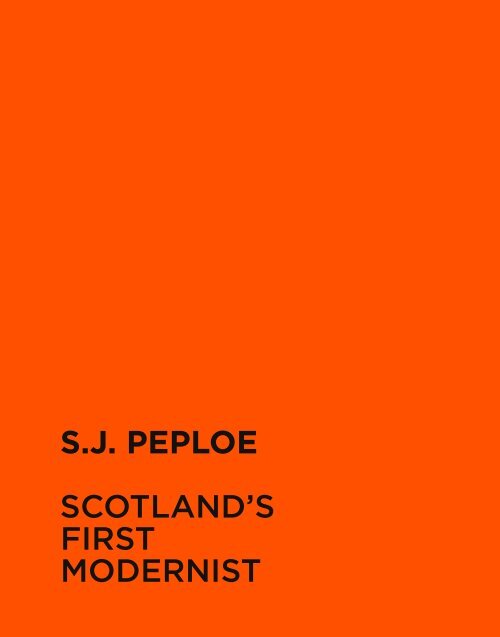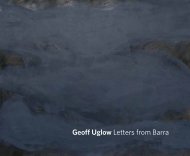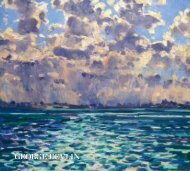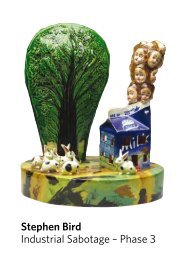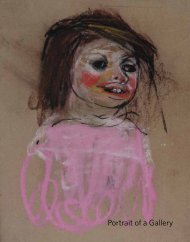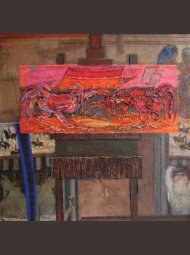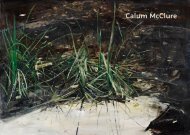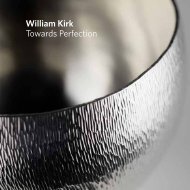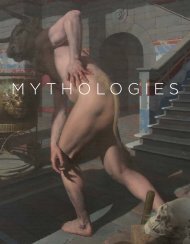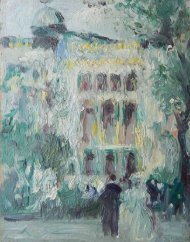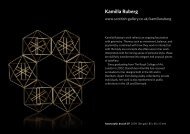Download PDF: SJ Peploe - The Scottish Gallery
Download PDF: SJ Peploe - The Scottish Gallery
Download PDF: SJ Peploe - The Scottish Gallery
Create successful ePaper yourself
Turn your PDF publications into a flip-book with our unique Google optimized e-Paper software.
Head of Old Tom Morris, c.1896Signed lower rightCharcoal on paper, 34.5 x 26.7 cmsIllustrated: S.J. <strong>Peploe</strong>, Guy <strong>Peploe</strong>, Lund Humphries, 2012 (p.33)Exhibited: S.J. <strong>Peploe</strong>, <strong>Scottish</strong> National <strong>Gallery</strong> of Modern Art,1985 (cat. 137)Two important paintings of Tom Morris, a well known ‘gentlemanof the road’ are in the collections of Glasgow Museums and<strong>The</strong> <strong>Scottish</strong> National <strong>Gallery</strong> of Modern Art, the latter knownas Man Laughing was first shown in <strong>Peploe</strong>’s first exhibition at<strong>The</strong> <strong>Scottish</strong> <strong>Gallery</strong> exhibition in 1903. <strong>The</strong> Glasgow picturedepicts him offering a ‘cheers’ with a wine-glass and is a few yearsearlier most likely painted in <strong>Peploe</strong>’s first studio in ShandwickPlace. <strong>The</strong> drawing will be a study from the earlier date. It is ofa type with the ‘stump’ drawings whose technique would havebeen taught at the Trustees Academy, but it does not seem atall an academic exercise being full of animation, character andmovement.6
<strong>The</strong> glass vase with similar flower arrangement sits on the mantelpiecein this photograph of Sam in his Devon Place Studio c.1902-4. <strong>The</strong>re is a‘baby’ painting similar to that on page 19 on the floor.Still Life with Roses, c.1898Oil on panel, 35 x 26.5 cmsProvenance: Willy <strong>Peploe</strong>, thence by descentStill Life with Roses combines the simplicity and sophisticationcharacteristic of <strong>Peploe</strong>’s still lifes. His props are confined to cloth,fan and vase with two rose heads, the space created with a seriesof subtle triangulations. A fallen rose petal (while not necessarilyladen with symbolic significance!) is completely necessary forthe balance of the composition.<strong>Peploe</strong> began to exhibit about this time and, never prolific,this work might well have been included in his first solo show at<strong>The</strong> <strong>Scottish</strong> <strong>Gallery</strong> in 1903.8
Comrie, c.1900Signed lower right and versoOil on panel, 12.3 x 21.5 cmsProvenance: <strong>The</strong> Artist, thence by descent<strong>Peploe</strong> is likely to have first come to Comrie after his sister Anniemarried Dr Fred Porter, who became the village doctor in around1898. He walked the countryside around and made several freelypainted studies on panel depicting hill and cloud. This pictureis made looking across the river Earn towards the town, justeast of the bridge which leads to Dalinross, where his sisterand brother-in-law had their house. A year or two later he willpaint his famous street scene including horse and carriage anda fashionable lady with a parasol: A Street, Comrie, lending thevillage a thoroughly Continental air. In Comrie his palette is stillrestricted but the brilliant brushwork always characteristic of hisen plein air practice is already evident.10
Landscape in the Hebrides, c.1903Signed verso and titled on fragmentary labelOil on panel, 15 x 23 cmsProvenance: Fine Art Society, London, 1958 & 1977; PrivateCollectionThough not specified and the exact location unlikely to bediscovered the subject of Landscape in the Hebrides is withoutdoubt Barra. <strong>Peploe</strong> is strongly associated with Iona where hevisited annually from 1919 until 1934 but he did visit other islandsin the Hebrides, most significantly Barra. <strong>The</strong> first visit was in 1894when he and his older brother Willie sailed with their friend thepainter RC Robertson in his ketch Nell. It was on this trip that hemet his future wife Margaret Mackay. She was from Loch Boisdalein South Uist but was working in the Post Office in Castlebay,Barra. <strong>The</strong>y began a correspondence and she eventually followedher heart to Edinburgh, courtesy of a transfer to the Post Officein Frederick Street!<strong>Peploe</strong>’s landscape studies are always true to the momentand his technical approach an instinctive response to his subject:here the generous, painterly strokes evoke a beautiful Hebrideanday. In the only known painting from his first visit to Barra nineyears before, <strong>Peploe</strong> depicted a milkmaid and cow. <strong>The</strong> cow ishere, but no milkmaid perhaps demonstrating how the artisthas little interest in genre; his subject now is pure landscapeimpressionism.12
Barra Landscape, c.1903Signed lower rightOil on panel, 15.5 x 23.5 cmsProvenance: Alex Reid and Lefevre, London, 1946; JW BlythCollection; <strong>The</strong> Taste of JW Blyth, July 2012, <strong>The</strong> <strong>Scottish</strong> <strong>Gallery</strong>,Edinburgh<strong>The</strong>re is a reference in a letter to a visit <strong>Peploe</strong> made to Barra in1903 so that is the date attributed to most of the known works hepainted there. He might well have visited several times as there issignificant stylistic variety within the Barra pictures which couldindicate earlier and later trips to the island. He painted on smallerpanels, for which he used a ‘pochard’ painting box which allowedhim freedom to roam the island to find his subjects. Castlebayitself provided several subjects, sometimes observed from therampart of Kisimul Castle in the bay, the ancestral strongholdof the MacNeils of Barra, but <strong>Peploe</strong> also ventured to the north ofthe island where great, sweeping beaches extend below machairand rocky escarpments. Today the airplane lands at low tideon Traigh Mhor but this picture is the view south from Seal Bayincluding the spur of Hierval on the horizon.14
Barra, c.1903Oil on panel, 16.5 x 24.2 cms<strong>The</strong> location of this panel is again the Atlantic side of the island butlooking north across the bay at Craigston toward the promontorywhich features Barra’s rather primitive nine hole golf course, themost westerly in the British Isles. Technically the creamy oil paint(spotted with sand) is the same quality as will be seen in NorthernFrance over the proceeding years and the palette is naturalisticand very true to place and weather.16
Baby, c.1904Signed lower rightOil on panel, 24 x 16.5 cmsProvenance: <strong>The</strong> Proudfoot Collection; <strong>The</strong> <strong>Scottish</strong> <strong>Gallery</strong>,Edinburgh; <strong>The</strong> Fine Art Society, London, May 1987Baby belongs to a group of human-subject pictures the artistmade in his Devon Place studio in the early years of the 20thcentury. <strong>The</strong>se include Man Laughing, a portrait of a chubby boyrecently with Aberdeen Art <strong>Gallery</strong>, several self-portraits andthe many images of Jeannie Blyth. For each the painter has sethimself a challenge: to paint animation, sometimes to embracethe conventionally ugly (for which he is criticised by Sir JamesCaw) but always to work at a pitch of intensity and risk, tocapture something fleeting and allow the paint its full expressivepotential.<strong>The</strong> sitter is not known but it is tempting to imagine it to be achild of Jeannie Blyth who had first sat for <strong>Peploe</strong> in around 1896but was married by 1900.18
By Firelight, c.1908Signed lower leftOil on canvas, 51 x 41 cmsProvenance: Alex Reid and Lefevre, London; T. R. Annan andSons Ltd, Glasgow; Mr Ernest N. Marshall; <strong>The</strong> <strong>Scottish</strong> <strong>Gallery</strong>,Edinburgh, 1981; Private CollectionExhibited: Arts Council, S.J. <strong>Peploe</strong>, 1953, (cat. 45); Glasgow Art<strong>Gallery</strong> and Museum, <strong>Scottish</strong> Painting, 1961, (cat. 160); <strong>Scottish</strong>Arts Council, Three <strong>Scottish</strong> Colourists, 1970, (cat. 63); New York,<strong>The</strong> Artist Group, Modern <strong>Scottish</strong> & English Paintings 1885-1955,April 1989, (cat. 17)By Firelight was painted in the period soon after 1905 when<strong>Peploe</strong> moved to his new studio at 32 York Place in Edinburgh.<strong>The</strong> new studio was the antithesis of his former studio at DevonPlace, with lofty proportions and large north facing windows.It had been built for the great portrait painter Raeburn in 1795.<strong>Peploe</strong> began a series of pictures at York Place which investigatedthe effects of lighting upon still lifes and figurative subject. In itsdramatic study of tones and flickering light, By Firelight is one ofthe most startlingly fluid paintings of this period with echoes ofLavery and Walton’s flamboyant elegance. <strong>The</strong> model was posedin front of <strong>Peploe</strong>’s white marble mantelpiece which had beendesigned for Raeburn in the style of Robert Adam. <strong>The</strong> paintingis built up of soft grey and pink tones with dark shadows paintedin rich black. At this time <strong>Peploe</strong>’s technique of paint applicationbecame broader and he adopted a medium which gave a richersurface and which appeared to hold the brush marks with a stillfuller body of paint.<strong>The</strong> model for By Firelight was the beautiful Peggy Macrae‘… a charming, witty, and attractive girl, who had the rare giftof complete grace which made her every movement interesting;she dropped naturally into poses which were balanced andharmonious and, better still, she immediately impersonated thefigure she was asked to represent… Peggy Macrae fitted perfectlyinto the pale grey, polished black and white sofa of <strong>Peploe</strong>’s newsetting, and she was the original of many of the figure picturesin pink, grey, and black.’ (<strong>Peploe</strong>; An Intimate Memoir of an Artistand of his Work, Stanley Cursiter, 1947, p. 17)20
Girl, c.1908Sanguine drawing, 26.6 x 23.5 cmsProvenance: <strong>The</strong> Artist and thence by descent22
Standing Nude with Clasped Hands, c.1911Conté, 26.5 x 17.5 cms23
Interior with Chair, Fan and Still life, c.1908Oil on canvas, 25.4 x 30.4 cmsProvenance: Willy <strong>Peploe</strong>, thence by descentThis small interior belongs in <strong>Peploe</strong>’s white period when heoccupied the Raeburn Studio in York Place, Edinburgh. It was herehe painted several dramatic single figure paintings using PeggyMacrae as his model, such as Girl in White and By Firelight (p.20).<strong>The</strong> palette is severely limited but contains a brilliant, scarletflash of fabric and other subtle notes. <strong>The</strong> painting is remarkablyfree and made alla prima, without revisions to gain an exquisitebalance of form and fluidity and represents the limit of how farthe artist will travel in this direction.24
Le Jardin, c.1910Signed lower leftOil on panel, 35.5 x 25 cmsExhibited: <strong>The</strong> <strong>Scottish</strong> Colourists in Paris, Galerie Francis Barlier,Paris, 2003Provenance: Private CollectionLiving in a small studio apartment at 278 Ble. Raspail withMargaret and new baby (Willy, having been born in Royan inAugust), the Luxembourg Gardens was the artist’s nearest parkand he completed many brilliant, Impressionist, small panelsincluding the statuary, Palace, and trees. In this painting <strong>Peploe</strong>uses the primed white board as the dominant component of hiscomposition as the sunlight coming through the trees seems todissolve the form of the urn. As with his drawings <strong>Peploe</strong> canpaint with remarkable economy but still suggest a complete andsatisfying subject.26
Mother and Child, c.1910Ink on paper, 10 x 7 cmsProvenance: Summer Exhibition, <strong>The</strong> <strong>Scottish</strong> <strong>Gallery</strong>, Edinburgh,July 1996<strong>The</strong> subject is certainly the painter’s family, Margaret and Willy inParis in 1910. <strong>The</strong>se rapid brush drawings are typical of the workhe submitted to the periodical Rhythm in 1911.Sam, Margaret and baby Willy c.191028
Abstract Design, c.1911Ink & oil on paper, 16 x 12 cmsProvenance: <strong>The</strong> Artist and thence by descentFrom 1908 Fergusson had become a sociétaire of the Salon desIndépendants, and with his encouragement <strong>Peploe</strong>, living inParis from the Spring of 1910, became fully engaged with thislife, introduced to many painters, including Picasso. He sent workinto the salons and contributed 15 drawings to the periodicalRhythm in 1911-12. Fergusson, as art editor, selected drawingsby Picasso, Gaudier-Brzeska and Derain, some images suppliedby the influential private dealer Daniel Kahnweiler as well as hisown circle of artist friends. <strong>The</strong> <strong>Peploe</strong> drawings were clearlyconceived for publication strongly graphic and made with penand brush. It was also at this particular moment that <strong>Peploe</strong>produced a few abstract designs in ink and colour. He did notcontinue with this kind of drawing and there are no paintings ofthe same conception however it is not far-fetched to see workslike this as being preparatory for the ‘experimental’ still lives ofthis time, particularly Still Life, c.1912, SNGMA (illus. below) andStill Life with Bottle (p.33).30
Still Life with Bottle, c.1912Signed lower rightOil on canvas, 51 x 51 cmsProvenance: Aitken Dott and Son (<strong>The</strong> <strong>Scottish</strong> <strong>Gallery</strong>),Edinburgh in early 1920s; Private CollectionStill Life with Bottle is one of a small group of still lifes ofthis moment which use a deliberately contrived or abstractbackground. Like Still Life (p.30), in the collection of the <strong>Scottish</strong>National <strong>Gallery</strong> of Modern Art, which was referred to by theScotsman critic reviewing the SSA exhibition of 1912 as cubistic,this picture is a clear attempt to analyse the subject in terms ofgeometry. <strong>The</strong>se works may be termed experimental but at thesame time they are entirely successful in their own terms: <strong>Peploe</strong>was too subtle and gifted a painter to let a style dominate overthe painterly and colourist qualities he brings to bear on eachpicture.32
Île de Bréhat, Brittany, 1911Signed lower rightOil on canvas board, 33 x 40.5 cmsProvenance: New Acquisitions, <strong>The</strong> <strong>Scottish</strong> <strong>Gallery</strong>, Edinburgh,January 2007, (cat. 3); Private CollectionExhibited: S.J. <strong>Peploe</strong>, <strong>Scottish</strong> National <strong>Gallery</strong> of Modern Art,1985 (cat. 55)Illustrated: S.J. <strong>Peploe</strong>, Guy <strong>Peploe</strong>, Lund Humphries, 2012 (p.87)<strong>Peploe</strong> visited the Île de Bréhat in the summer of 1911. It is a smallisland three kilometres off the north Brittany coast, not far fromthe fishing village of Paimpol. <strong>The</strong> island is reached by a fishingboatferry, has one hotel and a few holiday cottages. <strong>Peploe</strong> madeperhaps only a half-dozen works here all on the larger canvasboardsbought from the Paris American Art Co. in Montparnasseand which he used again in Cassis in 1913.<strong>The</strong>se few works are an advance from the previous year inRoyan. <strong>The</strong> solid, four-square buildings and rocks lend themselveswell to a more structured treatment than the marina and seafrontof Royan while the brilliant oranges of Royan are now temperedby intense, maritime aquamarines.34
Street Corner, Cassis, 1913Signed with initials lower rightConté, 22 x 15 cmsProvenance: <strong>The</strong> Artist and thence by descent36
Traiteur, Cassis, 1913Signed lower rightConté, 15 x 22 cmsProvenance: <strong>The</strong> Artist and thence by descent37
<strong>The</strong> Castle, Cassis, 1913Signed with initials lower rightConté, 14.5 x 22 cmsExhibited: <strong>The</strong> <strong>Scottish</strong> Colourists in Paris, Galerie Francis Barlier,Paris, 2003On his first trip to Cassis <strong>Peploe</strong> filled a sketchbook with quick,fine drawings of the many subjects in which he saw potential forpaintings; the narrow streets, the harbour front, the schooners inthe harbour, the castle high above the town and the dry maquisabove were all recorded and many painted also.Sam and Willy in the Hotel Panorama, Cassis, c.191338
Trees at Douglas Hall, 1916Signed lower right and inscribed with title versoOil on panel, 40.5 x 32 cmsIllustrated: S.J. <strong>Peploe</strong>, Guy <strong>Peploe</strong>, Lund Humphries, 2012 (p.131)Douglas Hall is a hamlet sitting above Sandyhills Bay to where<strong>Peploe</strong> came in 1915 on a trip to Dumfriesshire. He made severalvisits to the South West of Scotland, partly at the urging of hisfriends from Paris days, E.A. Taylor and Jessie M. King who hadby then settled in Kircudbright. <strong>Peploe</strong> had been rejected for WarService and thought that time in the countryside would be goodfor his health.He worked in Kircudbright itself, painting the Tolbooth, theharbour as well as Laggan Farm but surely did not make a moredramatic, brilliant picture than this. Trees were a lifelong favouritesubject for <strong>Peploe</strong> and the great pines at Cassis, Antibes andRothiemurchus inspired some of his greatest works towards theend of his life. Here he paints in a colour key as brilliant as any fauveartist but the trees have the majesty and presence of Cézanne;here is expressionism and structure combined successfully.40
Sam, Denis and Margaret at the ‘Bay at the Back of the Ocean’,Iona, c.1925.Rocks, Iona, c.1920Oil on panel, 36.8 x 44 cmsProvenance: Fine Art Society, London; <strong>The</strong> Fleming Collection,London, 1968; Private Collection<strong>Peploe</strong> first visited Iona in 1919 and was a regular and frequentvisitor until 1933. <strong>The</strong> Iona subjects were very popular andhelped cement his reputation in the 1920s. Iona is a small island,dominated by the green of the machair but <strong>Peploe</strong> only paintedat the North End where sand and rocks give way to sea and theislands beyond. He never painted a single blade of grass!42
White Roses and Fruit, c.1921Signed bottom leftOil on canvas, 51 x 40.5 cmsProvenance: Three <strong>Scottish</strong> Colourists, Fine Art Society, Edinburghand London, 1977, (cat. 40); Private CollectionIllustrated: S.J. <strong>Peploe</strong>, Guy <strong>Peploe</strong>, Lund Humphries, 2012 (p.131)<strong>Peploe</strong>’s rose pieces from this period are sublime images andfor many the most enduring and successful of all his oeuvre.<strong>The</strong>y represent the beauty of the natural world, the blooms sofresh seem almost fragrant, but are also a successful synthesisof cubist analysis and Cézannesque realism. <strong>The</strong>y are a subtleprogression on from the more stylised tulips and roses of theprevious years towards naturalism, but with no sacrifice of colour.In this example the slim blue and white vase and brilliant whiteof the roses are the central focus and stand out against the rich,velvety blues of the background and the hot orange of the fruitlend warmth to the palette.44
Still Life with Crock, c.1917Signed lower rightOil on canvas, 63.5 x 75 cmsProvenance: S.J. <strong>Peploe</strong> Paintings, <strong>The</strong> <strong>Scottish</strong> <strong>Gallery</strong>, Edinburgh,1990, (cat. 19); Major David Russell, Rothes, Fife; <strong>The</strong> <strong>Scottish</strong>Colourists in Paris, Galerie Francis Barlier, Paris, 2003; PrivateCollectionFor a short period <strong>Peploe</strong> painted still lifes which seem to owea direct debt to Paul Cézanne: the simple, even rustic subjectmatter, chosen for simplicity of form and rich, soft texture, theshallow picture space defined with a draped backdrop andthe analysis of the components in terms of simple geometry.But as ever with <strong>Peploe</strong> the application of paint is brilliant andthe colour harmonious. Within a few months he moved studioto 54 Shandwick Place and began to paint the very bright,schematic tulip and rose paintings which re-made his reputationand brought much needed commercial success.46
Nude, 1929Signed lower rightOil on canvas, 45.7 x 40.6 cmsProvenance: Alexander ReidExhibited: Two <strong>Scottish</strong> Colourists, <strong>The</strong> Lefevre <strong>Gallery</strong>, London,1988, (cat. 13)<strong>Peploe</strong> returned to painting nudes late in his career and madetwo monumental pictures and several smaller studies includingLittle Nude in the National Collection and this painting. He drewfrom the life model throughout his life but painted the nude onlyat the beginning and end of his painting life.48
S.J. PEPLOE, RSA (1871-1935)brief chronology1871 Born on 27 January, Edinburgh1891-4 Attended classes at Edinburgh School of Art, AcadémieJulian and Académie Colarossi in Paris where he won asilver medal in 18941894 First visited Barra1895 Awarded the Maclaine Watters medal at the Royal<strong>Scottish</strong> Academy (RSA) Life ClassTook a studio in the Albert Buildings in Shandwick Place,Edinburgh1896 First work, Charcoal Sketch, exhibited at Royal GlasgowInstitute (RGI)1897 First painting, Children, exhibited at RGI1898 First painting sold through Aitken Dott & Son1900 Short holiday in Paris before moving studio to 7 DevonPlace, Edinburgh1902 Painted in Comrie1903 Painted in North Berwick in July, Comrie in Septemberand Barra in early NovemberFirst exhibition at Aitken Dott & Son in October (from1897 onwards Aitken Dott & Son held exhibitions underthe name <strong>The</strong> <strong>Scottish</strong> <strong>Gallery</strong>)1904 First painting holiday with J.D. Fergusson in northernFrance1905 Moved to studio at 32 York Place, Edinburgh, built by HenryRaeburn in 1795 for his portrait painting requirements1907 Painted in Paris-Plage and went on to ParisHad a picture bought from the RSA by the newly formed<strong>Scottish</strong> Modern Arts Association1909 Second exhibition at Aitken Dott & Son, <strong>The</strong> <strong>Scottish</strong><strong>Gallery</strong>, Edinburgh1910 Married Margaret Mackay and shortly afterwards movedto Paris to a studio apartment at 278 Boulevard RaspailPainted at Royan where his first son Willy was born1911 Painted on the Île de Bréhat in the summer, then returnedalone to Edinburgh in July to raise money50
1912 <strong>The</strong> <strong>Peploe</strong> family had returned to Edinburgh by Juneand bought a flat at 13 India Street, S.J. <strong>Peploe</strong> taking anew studio at 34 Queen Street1913 Exhibited at the New <strong>Gallery</strong>, Shandwick Place, EdinburghPainted at Cassis, with J.D. Fergusson and Anne EstelleRice, and on Arran1914 Second son, Denis, is bornPainted at Crawford, near Beattock1915 Painted at Kirkcudbright1917 Painted again at various locations in the south-west ofScotland1918 Elected Associate of the RSANew studio at 54 Shandwick Place1920 First of regular visits to Iona1922 Exhibition at Aitken Dott & Son, <strong>The</strong> <strong>Scottish</strong> <strong>Gallery</strong>,Edinburgh1923 First of two group shows at the Leicester Galleries, LondonExhibition at Aitken Dott & Son, <strong>The</strong> <strong>Scottish</strong> <strong>Gallery</strong>,Edinburgh1924 Painted at Cassis, staying with family and F.C.B. Cadell atHôtel PanoramaExhibition, Les Peintres de l’Ecosse Moderne: F.C.B.Cadell, J.D. Fergusson, Leslie Hunter, S.J. <strong>Peploe</strong>, GalerieBarbazanges, ParisExhibition at Aitken Dott & Son, <strong>The</strong> <strong>Scottish</strong> <strong>Gallery</strong>,Edinburgh1926 Painted at New Abbey, Dumfriesshire1927 Elected Member of the RSAExhibition at Aitken Dott & Son, <strong>The</strong> <strong>Scottish</strong> <strong>Gallery</strong>,Edinburgh1928 Painted at Antibes and Cassis, and at Sweetheart Abbeyin DumfriesshireExhibition in New York at C.W. Kraushaar Galleries1930 Exhibition at Aitken Dott & Son, <strong>The</strong> <strong>Scottish</strong> <strong>Gallery</strong>,Edinburgh1931 Painted at Kirkcudbright for the last timeGroup exhibition, Les Peintres Ecossais: at Telfer Bear,R.O. Dunlop, Galerie Georges Petit, ParisTwo paintings purchased by the French State (seenote p.52)1932 Took a studio on the corner of Queen Street and CastleStreet, Edinburgh51
1933 Taught advanced life-class students at Edinburgh Collegeof Art for four termsPainted at Calvine in Perthshire, staying with Mr and MrsA.G. Sinclair1934 Painted at Rothiemurchus and became increasingly illExhibition at Aitken Dott & Son, <strong>The</strong> <strong>Scottish</strong> <strong>Gallery</strong>,Edinburgh1935 Died on 11 October and was buried at the Dean Cemetery,EdinburghTranslation: “Thank you sir for your kind letter. <strong>The</strong> <strong>Scottish</strong> Exhibitionwas excellent and the works you sent were particularly interesting. I amdelighted with the two pictures the Musee L’ouvre have bought. My bestcompliments, AD.”Andre Dezarrois is a significant figure in the history of French art. Hewas Director of the contemporary art magazine ‘La Revue d’Art’ andlater became Director of Foreign Art at the new Jeu de Paume whenit opened its doors to the public in 1933. In the 1920s and 30s publicfeeling still swayed toward traditional French painting. It was Dezarroisand a number of others who realised the existence of a significant foreignpresence living and working in Paris that was not being recognized bythe French State. Dezarrois heralded a change throughout the 1930s byorganising exhibitions of foreign artists who were living and working inParis. Exhibitions he organised included Picasso, Matisse, Kandinsky, Miro,Klee and Magritte. He was also responsible for buying foreign art for theFrench national collection, and bought two S.J. <strong>Peploe</strong>s from Les PeintresEcossais at Galerie Georges Petit in 1931.52
post mortem1936 Memorial Exhibition, Aitken Dott & Son, <strong>The</strong> <strong>Scottish</strong><strong>Gallery</strong>, Edinburgh1939 Exhibition of <strong>Scottish</strong> Art, Royal Academy of Arts, London1941 Exhibition at <strong>The</strong> National <strong>Gallery</strong> of Scotland, Edinburgh1947 Exhibition at Aitken Dott & Son, <strong>The</strong> <strong>Scottish</strong> <strong>Gallery</strong>,Edinburgh1949 Exhibition of Paintings by S.J. <strong>Peploe</strong>, F.C.B. Cadell andLeslie Hunter, Festival Exhibition, Royal <strong>Scottish</strong> Academy,Edinburgh1952 Festival Exhibition, Aitken Dott & Son, <strong>The</strong> <strong>Scottish</strong><strong>Gallery</strong>, Edinburgh1961 <strong>Scottish</strong> Painting, Glasgow Museums and Art <strong>Gallery</strong>1970 Three <strong>Scottish</strong> Colourists: Cadell, Hunter, <strong>Peploe</strong>, <strong>Scottish</strong>Arts Council, Touring Exhibition1985 Retrospective exhibition at <strong>The</strong> <strong>Scottish</strong> National Galleyof Modem Art (the first exhibition in the new JohnWatson’s building opened by Her Majesty <strong>The</strong> Queen)1990 Drawings, Aitken Dott & Son, <strong>The</strong> <strong>Scottish</strong> <strong>Gallery</strong>,Edinburgh2000 <strong>The</strong> <strong>Scottish</strong> Colourists, Royal Academy, Sackler Galleries,London, and (from November) <strong>Scottish</strong> National <strong>Gallery</strong>of Modern Art, EdinburghGuy <strong>Peploe</strong> publishes S.J. <strong>Peploe</strong>, the first majormonograph on the artist2003 <strong>The</strong> <strong>Scottish</strong> Colourists, <strong>The</strong> <strong>Scottish</strong> <strong>Gallery</strong> at GalerieFrancis Barlier, Paris2005 Drawings, Aitken Dott & Son, <strong>The</strong> <strong>Scottish</strong> <strong>Gallery</strong>,Edinburgh2009 Exhibition at Aitken Dott & Son, <strong>The</strong> <strong>Scottish</strong> <strong>Gallery</strong>,Edinburgh2012 Retrospective exhibition at <strong>The</strong> <strong>Scottish</strong> National <strong>Gallery</strong>of Modern Art, EdinburghScotland’s First Modernist, exhibition at Aitken Dott &Son, <strong>The</strong> <strong>Scottish</strong> <strong>Gallery</strong>, EdinburghGuy <strong>Peploe</strong>’s book, S.J. <strong>Peploe</strong>, is republished by LundHumphries53
Clockwise from top: <strong>Peploe</strong> with his students, Edinburgh College of Art, Easter 1934; Sam, agedabout eight; <strong>The</strong> artist in his Devon Place Studio, c.1901.54
S.J. PEPLOEBY GUY PEPLOEPublished by Lund HumphriesPrice: £35.00Book signing on Saturday 6 October 2012 11am - 2pm<strong>The</strong> exhibition accompanies a new publication of Guy <strong>Peploe</strong>’sbook S.J. <strong>Peploe</strong> with Lund Humphries. It is a fully revised andexpanded edition of his book first published in 2000. <strong>The</strong>reare 160 colour images and extensive use of family archives ofletters and photographs which lends insight into the life of oneof Scotland’s best loved painters. <strong>The</strong> text attempts to place himin the complex development of art which forms the emergenceof modernism in the early years of the 20th Century as well astell the story of a painter’s life with all its minor triumphs andsetbacks.Guy <strong>Peploe</strong> is a grandson of the artist as well as ManagingDirector of <strong>The</strong> <strong>Scottish</strong> <strong>Gallery</strong>, where <strong>Peploe</strong> had his firstexhibition in 1903 and is recognised as the foremost expert on<strong>The</strong> <strong>Scottish</strong> Colourists.55
Published by <strong>The</strong> <strong>Scottish</strong> <strong>Gallery</strong> to coincide with the exhibitionS.J. <strong>Peploe</strong>: Scotland’s First Modernist8 October – 3 November 2012Exhibition can be viewed online atwww.scottish-gallery.co.uk/sjpeploeThis exhibition will continue at <strong>The</strong> Portland <strong>Gallery</strong>, London7 November – 29 November 2012ISBN 978-1-905146-69-7Designed by www.kennethgray.co.ukPrinted by 21 ColourAll rights reserved. No part of this catalogue may be reproducedin any form by print, photocopy or by any other means, withoutthe permission of the copyright holders and of the publishers.56
Flowers, how wonderful they are: I have a bunch of tulips, so gay,of so many colours: orange, pink, different pinks, a strange one– pure brick red – which is my favourite; so sensitive to warmth;the tulip with the strange hot smell which seems to stir deepmemories, long-forgotten cities in a desert of sand, blazingsky, sun that is a torment; mauve ones, cool and insensitive.Living their closed, unrevealed life; unexposed, but keepingtheir beauty of form till the very end, longest of all, dark ones,opening and closing in slow rhythm.S.J. <strong>Peploe</strong>


